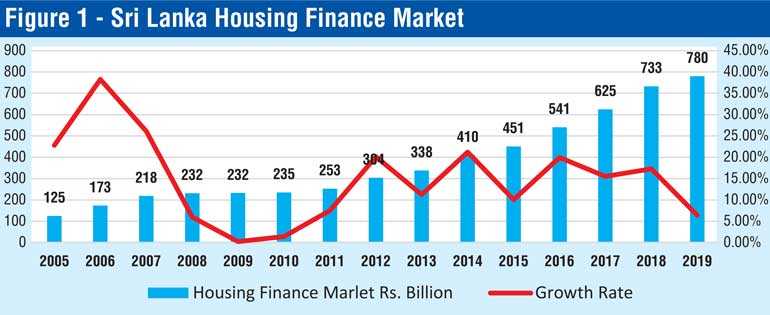Sunday Apr 20, 2025
Sunday Apr 20, 2025
Monday, 28 December 2020 00:00 - - {{hitsCtrl.values.hits}}

Housing finance, while helping households in realising housing dreams, plays a vital role in economies catalysing growth and prosperity. Housing finance stimulates Gross Domestic Product (GDP), by  promoting construction and real estate activities directly and inspiring SMEs, employments, housing market and finance and capital market development indirectly.
promoting construction and real estate activities directly and inspiring SMEs, employments, housing market and finance and capital market development indirectly.
Housing finance promotes homeownership, savings, investments, and more importantly leverage liquidity of the housing stock. Homeownership has compounding effect on inclusive socio-economic development.
As per UN-HABITAT, in low- and middle-income housing finance these benefits are much higher than the above average income housing finance. Low- and middle-income housing finance promotes financial inclusion, savings, access to credits and investments encouraging micro and small enterprises development. In Sri Lanka, informal construction sector plays a vital role in generating rural employments.
Housing finance market
Sri Lanka’s housing sector development has been substantially fuelled by the formal housing finance system underpinned by various demand side policy supports extended by the Government time to time.
As at today, estimated housing finance market (Housing finance outstanding in the banking system) is around Rs. 780 billion. The market has been swelling by leaps and bounds in the past 20 years, at rates hovering around 15%. However, over the last five years the market growth rates has substantially declined influenced by the contracting contribution from the Licensed Commercial Banks (LCBs) Figure -1.
Housing finance growth potential
Based on the last five years’ average growth rate, country’s housing finance market is predicted to reach Rs. 1,300 billion by 2025. But the potential and desired growth and contribution that can be made to economic expansion is much higher than the prediction.
As estimated, over the last five years, the country has spent Rs. 700-1,000 billion annually for residential fixed capital formation. Households’ savings, informal borrowings, microfinance, direct government investments have financed almost 90% of the investment and the estimated banking system’s contribution is only 10%.
Sri Lanka’s housing finance outstanding to GDP ratio is about 7%, whereas in Thailand 24%, Korea 33%, Malaysia 33%, Singapore 52%, USA 63%, Australia 90%, Netherlands 102%, and the world average is 31%, manifest the potential growth.
Below average income housing finance market
Housing finance market is highly segmented in terms of income levels. Above average income group is well served by LCBs and represents 72% of the Sri Lanka’s market. But the low- and middle-income segment is underserved. Only 28% of the housing finance market has penetrated into below average income households. That market represents the bottom two third of the income pyramid, which is about 70% of the households. Below average housing finance is an emerging market, and potentially, it would be the biggest housing finance market in the country, in the next two decades.
As evident, benefits of the most of the Government’s initiatives, policies and subsidies do not trickle down to this segment as expected. They are enjoyed by those who have higher affordability and accessibility to bank finance.
Estimated housing finance need
Other than the rising urban affordable housing needs, country is in need of upgrading around 1.2 million existing substandard houses, and another approximate 50,000 new houses yearly to accommodate the natural growth of the population, across the island. At an approximate cost of Rs. 750, 000 per units, estimated affordable housing finance need is around Rs. 1,000 billion within next five years. In this respect, the role, that the Government can play alone is limited.
If strategised correctly, it is a huge commercial and growth opportunity, that can be leveraged with private sector participation. In low- and middle-income market, customers have the capacity to pay for an affordable home loan, but the crucial issue is access to finance. More innovative and customised products and services are needed. It is a sellers’ market where lender can maintain appropriate risk-based margins.
In India, large number of private sector non-bank financial institutions are playing successfully in the below average income housing finance market. Those institutions are regulated by the National Housing Bank of India which is a 100% own subsidiary of RBI. National Housing Bank mobilises local and international funding to support those institutions facilitating for successful retail delivery of housing finance.
The need of a big housing finance bank
Without access to low-cost long-term funding, the institutions cannot develop; but low-cost long-term money will not flow to the institutions until they have adequate capacity. That is a classic chicken/egg situation; which the institutions are facing in this market.
Therefore, successful retail housing finance delivery requires a joint application of institutional capacity-building and funding, partly through capital-markets development and partly through international funding. Adequate and focused portfolio diversification, maintaining an appropriate mix of wider income housing finance, and penetrating into developer finance and development of real estate related derivatives, formulating real estate trust, and other form capital market vehicles are important in building institutional capacity and earnings.
Continuous improvement in accessibility and affordability is important for successful delivery of housing finance in this market.
In this background, a committed bank with higher institutional capacity is essential for expanding housing finance to below average income market and also realising the country’s growth and development targets, timely.
Such an institution needs adequate strength to absorb external shocks and support both end buyer and developer by raising local and international funding, issuing new derivatives, bonds and other form of capital market instruments.
An appropriate corporate structure is needed encouraging private sector active participation. Stock market listing and maintaining the Government ownership below 50% are vital factors, for the encouragement of private sector positive involvement.
Maintaining the Government shareholding in a substantial level of 40 to 49 percent may facilitate the institution to grow as a standalone bank and also to sourcing local and international capital market funding.
(The writer, D. Vidana Pathirana MBA, BSc, FCA, FCMA, is Former Chief Finance Officer, HDFC Bank of Sri Lanka. The sources of estimates and figures in this article, unless otherwise mentioned are as per the market research and analysis of the author, who can be reached via email: [email protected] and WhatsApp 0718800888.)
Discover Kapruka, the leading online shopping platform in Sri Lanka, where you can conveniently send Gifts and Flowers to your loved ones for any event including Valentine ’s Day. Explore a wide range of popular Shopping Categories on Kapruka, including Toys, Groceries, Electronics, Birthday Cakes, Fruits, Chocolates, Flower Bouquets, Clothing, Watches, Lingerie, Gift Sets and Jewellery. Also if you’re interested in selling with Kapruka, Partner Central by Kapruka is the best solution to start with. Moreover, through Kapruka Global Shop, you can also enjoy the convenience of purchasing products from renowned platforms like Amazon and eBay and have them delivered to Sri Lanka.
Discover Kapruka, the leading online shopping platform in Sri Lanka, where you can conveniently send Gifts and Flowers to your loved ones for any event including Valentine ’s Day. Explore a wide range of popular Shopping Categories on Kapruka, including Toys, Groceries, Electronics, Birthday Cakes, Fruits, Chocolates, Flower Bouquets, Clothing, Watches, Lingerie, Gift Sets and Jewellery. Also if you’re interested in selling with Kapruka, Partner Central by Kapruka is the best solution to start with. Moreover, through Kapruka Global Shop, you can also enjoy the convenience of purchasing products from renowned platforms like Amazon and eBay and have them delivered to Sri Lanka.